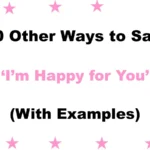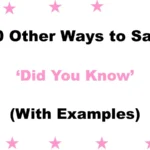In the workplace and in life, moments arise when someone shares difficult news—whether it’s personal loss, health issues, or professional setbacks. Using the right words to respond with empathy is essential. While “I am sorry to hear that” is polite and appropriate, repeating the same phrase can sometimes feel impersonal or overused. That’s why having a variety of alternatives can help your message feel more heartfelt, human, and sincere.
This article offers 30 thoughtful and professional ways to say “I am sorry to hear that,” each with examples, definitions, and guidance. Whether you’re writing an email, responding in a meeting, or messaging a client, these options help you express compassion and respect—while keeping your communication genuine and supportive.
What Does “I Am Sorry to Hear That” Mean?
“I am sorry to hear that” is a polite, professional way to respond when someone shares unfortunate or distressing news. It expresses sympathy and shows that you’re acknowledging their experience.
This phrase is commonly used when a deeper emotional response is needed but within formal or workplace-appropriate limits. It helps create a moment of connection, support, and humanity—especially during difficult conversations.
When to Use “I Am Sorry to Hear That”
- Personal Loss
- Health Issues
- Career Setbacks
- Emotional Struggles
Is It Professional or Polite to Say “I Am Sorry to Hear That”?
Yes, absolutely. “I am sorry to hear that” is considered both professional and polite, especially in formal settings. It acknowledges someone’s pain or disappointment without being too emotionally heavy or inappropriate. However, depending on your relationship with the person, using a more personalized phrase may make your support feel more genuine and thoughtful.
Pros or Cons for saying “I Am Sorry to Hear That”
Pros:
- Polite and respectful for all professional settings
- Safe default phrase when unsure how to respond
- Brief but effective in acknowledging emotional content
Cons:
- May come across as generic or impersonal if overused
- Can seem detached if not followed up with more empathy
- Might feel too formal for close colleagues or friends
Synonyms for “I Am Sorry to Hear That”
- That must be really difficult
- I’m here for you
- I can only imagine how hard that is
- My heart goes out to you
- I truly sympathize with what you’re going through
- That’s incredibly tough
- Please let me know if I can help
- Thinking of you during this time
- That’s never easy to go through
- I’m holding space for you
- You’re in my thoughts
- I’m sending support your way
- That sounds really challenging
- I wish I had better news for you
- That’s a heavy thing to carry
- I’m sorry you’re going through this
- My sincere condolences
- I’m deeply sorry to hear this
- That must feel overwhelming
- I hope you’re being kind to yourself
- I’m sending strength your way
- You’re not alone in this
- Please take all the time you need
- I’m sorry this happened
- I’m wishing you peace and strength
- I hate that you’re going through this
- It’s okay to feel this way
- Let me know how I can support you
- I admire your strength
- You have my full support
1. That must be really difficult
Definition: Expresses understanding and empathy for someone’s hardship.
Detailed Explanation: This phrase acknowledges emotional weight without being overly dramatic.
Scenario Example: A colleague shares news of a family emergency: That must be really difficult—please don’t hesitate to take time for yourself.
Best Use: In professional settings where you want to show support without overstepping.
Worst Use: When the situation is too formal for emotional language (e.g., legal notices).
Tone: Warm, compassionate, and respectful.
2. I’m here for you
Definition: A supportive phrase that shows emotional and practical availability.
Detailed Explanation: Signals that you’re offering comfort, help, or simply a listening ear.
Scenario Example: A coworker opens up about burnout: I’m here for you—if you ever need to talk or vent, I’ve got your back.
Best Use: In closer professional or peer relationships.
Worst Use: When boundaries or formal roles must be clearly maintained.
Tone: Reassuring, genuine, and slightly informal.
3. I can only imagine how hard that is
Definition: A respectful way to acknowledge someone’s struggle even if you haven’t experienced it yourself.
Detailed Explanation: It shows humility and empathy without pretending to fully understand.
Scenario Example: A teammate mentions going through a divorce: I can only imagine how hard that is—please know I’m thinking of you.
Best Use: When you don’t share the same experience but want to express sincere care.
Worst Use: If you actually do understand—this could feel dismissive.
Tone: Honest, kind, and humble.
4. My heart goes out to you
Definition: A classic phrase of sympathy often used in moments of personal or emotional pain.
Detailed Explanation: It’s a respectful way to share sorrow and solidarity in loss.
Scenario Example: A coworker loses a loved one: My heart goes out to you and your family during this difficult time.
Best Use: In messages of condolence or grief support.
Worst Use: In less serious situations—it may feel overly dramatic.
Tone: Formal, deeply caring, and sensitive.
5. I truly sympathize with what you’re going through
Definition: Expresses genuine compassion and understanding of someone’s difficulty.
Detailed Explanation: Indicates that you’re emotionally invested and not just responding politely.
Scenario Example: A friend at work is dealing with a sick parent: I truly sympathize with what you’re going through—it sounds incredibly hard.
Best Use: When you want to show deep, sincere empathy.
Worst Use: In very short messages where brevity is more appropriate.
Tone: Thoughtful, respectful, and serious.
6. That’s incredibly tough
Definition: A concise way to acknowledge that someone’s situation is emotionally or mentally draining.
Detailed Explanation: Keeps your response direct while still showing sympathy.
Scenario Example: A colleague shares news of a layoff: That’s incredibly tough—please let me know if there’s anything I can do.
Best Use: In conversation or quick responses that still need warmth.
Worst Use: If the tone comes across too casual in formal contexts.
Tone: Honest, compassionate, and modern.
7. Please let me know if I can help
Definition: A polite offer of support during difficult times.
Detailed Explanation: It shifts the focus to action, which can be comforting and practical.
Scenario Example: A teammate is overwhelmed with work after a family emergency: Please let me know if I can help lighten the load.
Best Use: When you’re ready to offer actual help—not just words.
Worst Use: If you don’t mean it—it can feel hollow.
Tone: Supportive, proactive, and respectful.
8. Thinking of you during this time
Definition: A formal yet heartfelt phrase often used in professional sympathy messages.
Detailed Explanation: It maintains distance while showing emotional presence.
Scenario Example: After hearing about a coworker’s loss: Thinking of you during this time—please accept my sincere sympathy.
Best Use: In email messages, cards, or formal HR notices.
Worst Use: In overly casual chats—it may feel stiff.
Tone: Polished, sincere, and professional.
9. That’s never easy to go through
Definition: A comforting way to validate the difficulty of a situation.
Detailed Explanation: It recognizes the emotional challenge without sounding exaggerated.
Scenario Example: A colleague talks about struggling with a medical diagnosis: That’s never easy to go through—I hope you’re finding support.
Best Use: When someone opens up and you want to acknowledge their strength.
Worst Use: In legal or highly formal letters—it may be too personal.
Tone: Empathetic, kind, and steady.
10. I’m holding space for you
Definition: A phrase rooted in emotional intelligence, meaning you’re mentally and emotionally available for them.
Detailed Explanation: It tells the other person they’re not alone and their feelings are valid.
Scenario Example: A teammate shares that they’re grieving: I’m holding space for you—take the time you need to heal.
Best Use: In emotionally intelligent workplaces or with teams that value mental health.
Worst Use: In corporate or highly formal settings—it may feel unclear.
Tone: Gentle, grounded, and emotionally supportive.
11. You’re in my thoughts
Definition: A gentle way to show someone you care about what they’re going through.
Detailed Explanation: This phrase expresses emotional support from a distance.
Scenario Example: After a tough meeting, you message a colleague: You’re in my thoughts—I hope things get better soon.
Best Use: In written messages, cards, or quiet moments of empathy.
Worst Use: In very active or action-focused settings—it may seem too passive.
Tone: Soft, warm, and thoughtful.
12. I’m sending support your way
Definition: A comforting way to say you care and want them to feel emotionally lifted.
Detailed Explanation: This phrase combines emotional empathy with the imagery of offering help.
Scenario Example: A friend shares health struggles: I’m sending support your way—let me know if you need anything.
Best Use: When you want to show distant but real emotional presence.
Worst Use: If used too frequently—it may sound generic.
Tone: Gentle, reassuring, and modern.
13. That sounds really challenging
Definition: A way to acknowledge someone’s struggle without over-assuming how they feel.
Detailed Explanation: It’s a balanced, validating response that keeps the focus on them.
Scenario Example: A colleague is juggling deadlines and family issues: That sounds really challenging—if you need a break, let’s talk.
Best Use: In empathetic one-on-one conversations.
Worst Use: If the situation is very serious—it might sound too mild.
Tone: Understanding, calm, and non-judgmental.
14. I wish I had better news for you
Definition: A professional way to deliver disappointment while showing empathy.
Detailed Explanation: This helps soften the blow when sharing unfortunate updates.
Scenario Example: Delivering rejected funding news: I wish I had better news for you—but I’ll keep advocating for your work.
Best Use: When you’re the bearer of bad news and want to be kind.
Worst Use: In high-emotion scenarios where reassurance is better than commentary.
Tone: Honest, caring, and diplomatic.
15. That’s a heavy thing to carry
Definition: An acknowledgment of emotional or psychological weight someone is bearing.
Detailed Explanation: Recognizes that someone is going through a difficult burden.
Scenario Example: A team member talks about caring for an ill parent: That’s a heavy thing to carry—I admire your strength.
Best Use: When someone confides in you personally.
Worst Use: In fast-paced chats where tone can be misunderstood.
Tone: Compassionate, reflective, and sincere.
16. I’m sorry you’re going through this
Definition: A direct and caring phrase that offers sympathy.
Detailed Explanation: It validates someone’s situation without assuming their feelings.
Scenario Example: After a coworker shares they’re struggling: I’m sorry you’re going through this—take the time you need.
Best Use: In supportive responses to difficult personal updates.
Worst Use: In scripted messages—it may sound robotic.
Tone: Straightforward, warm, and respectful.
17. My sincere condolences
Definition: A traditional and respectful way to offer sympathy after a loss.
Detailed Explanation: Often used in messages of bereavement or serious hardship.
Scenario Example: After hearing about someone’s passing: My sincere condolences to you and your family.
Best Use: In formal or professional condolence notes.
Worst Use: In casual messages—it may sound stiff.
Tone: Formal, polished, and respectful.
18. I’m deeply sorry to hear this
Definition: A heartfelt way to express sympathy with extra emotional weight.
Detailed Explanation: This phrase is stronger and more personal than a general “sorry.”
Scenario Example: After a friend loses a pet: I’m deeply sorry to hear this—I know how much they meant to you.
Best Use: In personal or heartfelt messages.
Worst Use: In short, transactional communications.
Tone: Deep, warm, and genuine.
19. That must feel overwhelming
Definition: Validates that the other person may feel emotionally flooded.
Detailed Explanation: Helps people feel seen without needing to explain further.
Scenario Example: A colleague explains back-to-back crises: That must feel overwhelming—please don’t hesitate to pause.
Best Use: When the other person looks or sounds emotionally overloaded.
Worst Use: In written notes where tone may not translate.
Tone: Honest, gentle, and aware.
20. I hope you’re being kind to yourself
Definition: Encourages self-compassion during hard times.
Detailed Explanation: Offers a gentle reminder to avoid self-blame or pressure.
Scenario Example: A coworker opens up about mistakes: I hope you’re being kind to yourself—no one gets it perfect every time.
Best Use: When someone feels guilt or self-doubt.
Worst Use: In situations where immediate problem-solving is needed.
Tone: Encouraging, warm, and non-critical.
21. I’m sending strength your way
Definition: A motivational phrase that blends care and resilience.
Detailed Explanation: Suggests that you’re thinking of them and wishing them inner power.
Scenario Example: A peer shares they’re exhausted from personal challenges: I’m sending strength your way—you’re not alone.
Best Use: When you want to boost someone’s inner courage.
Worst Use: In rigid corporate or formal letters.
Tone: Positive, hopeful, and energizing.
22. You’re not alone in this
Definition: Assures someone that they’re supported and seen.
Detailed Explanation: Great for reducing isolation during tough times.
Scenario Example: A team member talks about emotional burnout: You’re not alone in this—we’ll get through it together.
Best Use: In team environments or friendship-based workplaces.
Worst Use: In formal documents—it might sound too emotional.
Tone: Supportive, inclusive, and grounded.
23. Please take all the time you need
Definition: Encourages rest, recovery, or healing without pressure.
Detailed Explanation: Offers emotional permission to slow down.
Scenario Example: A colleague is returning after a loss: Please take all the time you need—we’ve got things covered.
Best Use: During grief, recovery, or personal emergencies.
Worst Use: When timelines are tight and cannot shift.
Tone: Kind, spacious, and flexible.
24. I’m sorry this happened
Definition: Expresses regret over someone’s hardship.
Detailed Explanation: Communicates compassion without assuming fault.
Scenario Example: After hearing about a mistake at work: I’m sorry this happened—let me know how I can help fix it.
Best Use: In moments of accidental harm or difficult news.
Worst Use: When it sounds like you’re taking unnecessary responsibility.
Tone: Gentle, accountable, and honest.
25. I’m wishing you peace and strength
Definition: Combines emotional balance and inner resilience.
Detailed Explanation: Offers a twofold wish for calm and power.
Scenario Example: After a serious loss: I’m wishing you peace and strength as you navigate this time.
Best Use: In sympathy notes or quiet encouragements.
Worst Use: When energetic support is more appropriate.
Tone: Calm, spiritual, and grounded.
26. I hate that you’re going through this
Definition: A very personal way to express that you feel deeply for someone.
Detailed Explanation: It shares frustration or sorrow over the situation.
Scenario Example: A friend shares emotional distress: I hate that you’re going through this—you deserve better.
Best Use: With close relationships where emotional honesty is valued.
Worst Use: In corporate or formal settings.
Tone: Passionate, authentic, and intense.
27. It’s okay to feel this way
Definition: Validates emotional experiences without judgment.
Detailed Explanation: Helps normalize the emotions someone may be experiencing.
Scenario Example: A teammate is embarrassed about their reaction: It’s okay to feel this way—your feelings are valid.
Best Use: When someone is self-critical or apologetic about emotions.
Worst Use: When the situation calls for redirection or problem-solving.
Tone: Reassuring, nonjudgmental, and comforting.
28. Let me know how I can support you
Definition: Opens a door to action while being respectful of boundaries.
Detailed Explanation: Encourages the other person to ask for what they need.
Scenario Example: A peer is grieving and quiet: Let me know how I can support you—I’m here in any way you need.
Best Use: When you’re ready to offer real help.
Worst Use: If you don’t intend to follow through.
Tone: Caring, thoughtful, and responsive.
29. I admire your strength
Definition: Acknowledges the resilience someone is showing through hardship.
Detailed Explanation: It helps the person feel seen and respected.
Scenario Example: A team member has been calm through a crisis: I admire your strength—it’s inspiring to all of us.
Best Use: When someone is visibly coping well despite challenges.
Worst Use: If they’re feeling too fragile—it may feel like pressure.
Tone: Uplifting, respectful, and affirming.
30. You have my full support
Definition: A strong way to let someone know you’re standing by them.
Detailed Explanation: Communicates loyalty and emotional or professional backup.
Scenario Example: A colleague is facing criticism: You have my full support—your efforts have been nothing short of remarkable.
Best Use: In leadership, peer encouragement, or advocacy.
Worst Use: When you can’t actually back it up with action.
Tone: Confident, firm, and affirming.
Conclusion
Finding the right words when someone is hurting isn’t always easy—but choosing thoughtful, empathetic alternatives to “I am sorry to hear that” can truly make a difference. Whether you’re writing a professional message, responding to a friend, or supporting a team member, these expressions show care, respect, and emotional intelligence.
Each alternative on this list offers a slightly different nuance—some more formal, others more personal—but all are designed to communicate support in a way that feels authentic. Remember, the key is not just saying the right words—it’s saying them with genuine intent.
FAQs
1. What’s the most professional alternative to “I am sorry to hear that”?
“My sincere condolences” or “You have my full support” are great professional options. They sound respectful and appropriate in formal settings, especially when writing emails or notes to colleagues or clients.
2. Can I use these alternatives in a business email?
Yes, many of these phrases—such as “I’m sorry you’re going through this”, “Please take all the time you need”, and “Let me know how I can support you”—are excellent for maintaining professionalism while still expressing empathy in emails or team communications.
3. Are these alternatives suitable for personal situations too?
Absolutely. Phrases like “You’re not alone in this”, “I admire your strength”, or “I hate that you’re going through this” are especially comforting in close friendships, family conversations, or more heartfelt moments.
4. Is “I’m sorry to hear that” considered outdated?
Not exactly—it’s still commonly used and understood. However, using more personalized phrases can make your message feel warmer and more emotionally intelligent, especially when the situation calls for more than a standard reply.
5. How do I know which phrase to choose?
Choose based on the relationship, the context, and the emotional tone. For example, a more formal client interaction might need “My sincere condolences”, while a close friend might appreciate “That must feel overwhelming” or “I’m sending strength your way.”

Mariah Cannon is a dedicated Senior Content Specialist at GrammarPeaks, known for her clear, engaging writing and deep knowledge of English grammar and usage. With a background in linguistics and years of experience in content development, Mariah crafts informative and accessible articles that empower readers to master the nuances of the English language. Her work reflects a commitment to clarity, education, and helping others express themselves with confidence.





